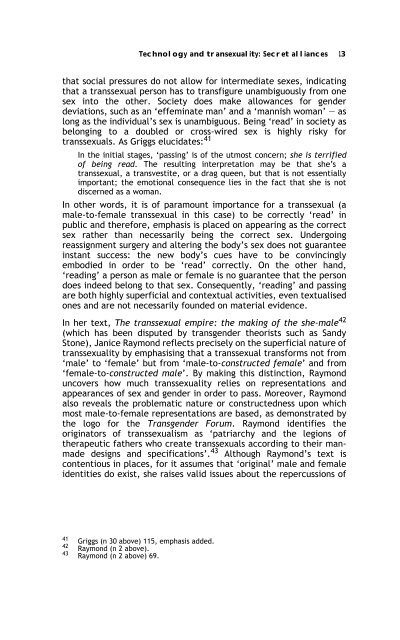Sex, Gender, Becoming - PULP
Sex, Gender, Becoming - PULP
Sex, Gender, Becoming - PULP
You also want an ePaper? Increase the reach of your titles
YUMPU automatically turns print PDFs into web optimized ePapers that Google loves.
Technology and transexuality: Secret alliances 13<br />
that social pressures do not allow for intermediate sexes, indicating<br />
that a transsexual person has to transfigure unambiguously from one<br />
sex into the other. Society does make allowances for gender<br />
deviations, such as an ‘effeminate man’ and a ‘mannish woman’ — as<br />
long as the individual’s sex is unambiguous. Being ‘read’ in society as<br />
belonging to a doubled or cross-wired sex is highly risky for<br />
transsexuals. As Griggs elucidates: 41<br />
In the initial stages, ‘passing’ is of the utmost concern; she is terrified<br />
of being read. The resulting interpretation may be that she’s a<br />
transsexual, a transvestite, or a drag queen, but that is not essentially<br />
important; the emotional consequence lies in the fact that she is not<br />
discerned as a woman.<br />
In other words, it is of paramount importance for a transsexual (a<br />
male-to-female transsexual in this case) to be correctly ‘read’ in<br />
public and therefore, emphasis is placed on appearing as the correct<br />
sex rather than necessarily being the correct sex. Undergoing<br />
reassignment surgery and altering the body’s sex does not guarantee<br />
instant success: the new body’s cues have to be convincingly<br />
embodied in order to be ‘read’ correctly. On the other hand,<br />
‘reading’ a person as male or female is no guarantee that the person<br />
does indeed belong to that sex. Consequently, ‘reading’ and passing<br />
are both highly superficial and contextual activities, even textualised<br />
ones and are not necessarily founded on material evidence.<br />
In her text, The transsexual empire: the making of the she-male 42<br />
(which has been disputed by transgender theorists such as Sandy<br />
Stone), Janice Raymond reflects precisely on the superficial nature of<br />
transsexuality by emphasising that a transsexual transforms not from<br />
‘male’ to ‘female’ but from ‘male-to-constructed female’ and from<br />
‘female-to-constructed male’. By making this distinction, Raymond<br />
uncovers how much transsexuality relies on representations and<br />
appearances of sex and gender in order to pass. Moreover, Raymond<br />
also reveals the problematic nature or constructedness upon which<br />
most male-to-female representations are based, as demonstrated by<br />
the logo for the Transgender Forum. Raymond identifies the<br />
originators of transsexualism as ‘patriarchy and the legions of<br />
therapeutic fathers who create transsexuals according to their manmade<br />
designs and specifications’. 43 Although Raymond’s text is<br />
contentious in places, for it assumes that ‘original’ male and female<br />
identities do exist, she raises valid issues about the repercussions of<br />
41 Griggs (n 30 above) 115, emphasis added.<br />
42<br />
Raymond (n 2 above).<br />
43 Raymond (n 2 above) 69.
















